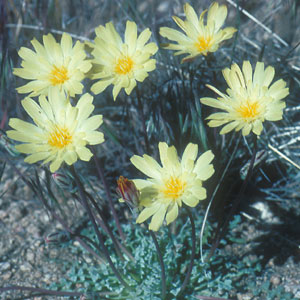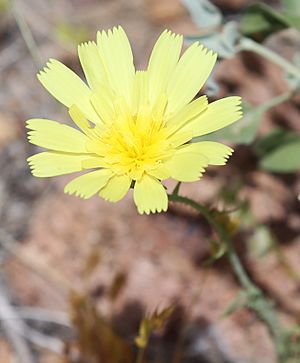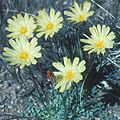Scale bud facts for kids
Quick facts for kids Scale bud |
|
|---|---|
 |
|
| Scientific classification | |
| Kingdom: | |
| (unranked): | |
| (unranked): | |
| (unranked): | |
| Order: | |
| Family: | |
| Tribe: |
Cichorieae
|
| Subtribe: |
Microseridinae
|
| Genus: |
Anisocoma
Torr. & A. Gray
|
| Species: |
A. acaulis
|
| Binomial name | |
| Anisocoma acaulis Torr. & A. Gray
|
|
The scale bud (scientific name: Anisocoma acaulis) is a unique wildflower. You can find it growing in the Mojave and Colorado Deserts. It also grows in California's Owens Valley. This plant lives in dry, sandy areas.
It grows at elevations from about 2,000 feet up to 7,000 feet. You can spot it in states like Arizona, Nevada, California, Baja California, and Sonora. The scale bud is the only plant in its entire group, called the Anisocoma genus.
This plant forms a flat mat of leaves that spread out on the ground. Its leaves have jagged, lobed edges. From this mat, stalks grow up to 20 centimeters (about 8 inches) tall. These stalks are topped with pretty flowers.
Contents
What Does the Scale Bud Look Like?
The scale bud plant has a special appearance. Its leaves lie flat on the ground. They are shaped like they have deep cuts or lobes.
Its Unique Flowers
The flowers of the scale bud bloom from April to June. They can be either yellow or white. Often, the white flowers have bright yellow centers. The individual petals, called ray florets, look frilly. They are shaped like rectangles with flat or slightly jagged tips.
Why Is It Called "Scale Bud"?
The common name "scale bud" comes from how the flower buds look before they open. They have a scaly appearance. This makes them look a bit like fish scales.
Where Does It Grow?
You'll often find scale bud plants growing together in groups. They prefer sandy places. They also like to grow in washes, which are dry streambeds that fill with water during rain. If you cut the plant, it will release a milky sap.
Images for kids
See also
 In Spanish: Anisocoma acaulis para niños
In Spanish: Anisocoma acaulis para niños



